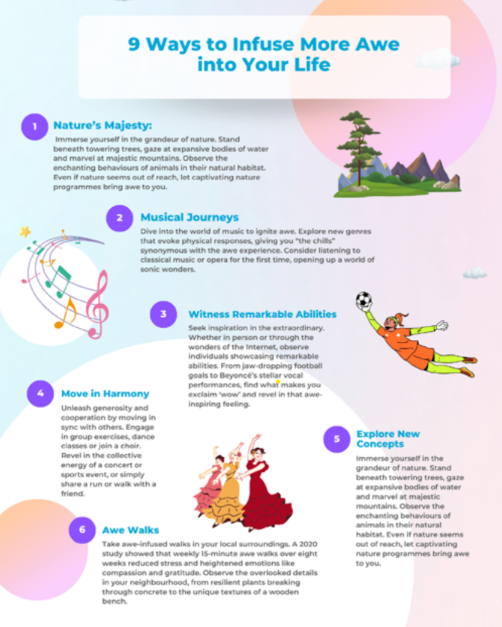Fostering Wonderment & Awe in the Classroom
A Habit of Mind for Lifelong Learning

While academic skills take centre stage in our schools, research unequivocally shows the significance of nurturing habits that instil curiosity, critical thinking and a lifelong passion for learning. Among these indispensable habits is, “Responding with Wonderment and Awe,” articulated by Art Costa and Bena Kallick in their groundbreaking exploration of Habits of Mind. This habit goes beyond conventional classroom walls, prompting both educators and students to perceive the world as amazing and awe-inspiring.
At its core, Responding with Wonderment and Awe is a cognitive and emotional disposition that encourages people to approach the world with a sense of reverence and fascination. It involves perceiving the extraordinary in the ordinary, finding beauty in simplicity, and maintaining a sense of awe for the complexity and interconnectedness of the world. This Habit of Mind goes beyond routine observation – it sparks a deep curiosity and an ongoing desire to explore and understand the marvels of our surroundings. The ability to respond to the outside and inner world might be paralleled with self-awareness and the ability to think about your thinking – metacognition. Physical signs you are experiencing awe include goosebumps, a dropped jaw and a caught breath. Wonder often evokes questions and ponderings as to how and why.
Benefits of Responding with Wonderment and Awe:
• Fosters Lifelong Learning:
Encouraging the habit of Responding with Wonder and Awe sets the stage for a lifelong love of learning. Students who approach the world with curiosity are more likely to seek out new information, ask questions and engage in independent exploration.
• Enhances Critical Thinking:
Wonderment and Awe inspires humans to think critically and reflect on the mysteries of the world. This habit encourages students to analyse, question and explore diverse perspectives, fostering a deeper understanding of complex concepts.
• Promotes Well-being:
Embracing a sense of wonder can have positive effects on emotional well-being. It nurtures a positive mindset, resilience and an appreciation for the beauty in both success and setbacks.
Renowned psychology professor, Dacher Keltner, co-founder of the Greater Good Science Centre at the University of California, Berkeley, asserts that awe has the remarkable ability to “sharpen our brains.” His research indicates that experiencing awe not only enhances cognitive functions but also has notable social benefits. Individuals who regularly encounter awe-inspiring moments exhibit increased levels of compassion and generosity.
Furthermore, additional studies in this realm reveal compelling health benefits. There is a notable decrease in markers associated with chronic inflammation, a factor linked to serious conditions such as cancer, heart disease, diabetes, arthritis and bowel diseases. Furthermore, individuals who incorporate a sense of wonder into their lives exhibit reduced rumination, a cognitive process associated with depression.
• Encourages Creativity & Innovation:
Wonderment and Awe often lead to increased creativity as individuals explore unconventional ideas and solutions. Encouraging students to find beauty in diverse subjects and experiences can stimulate their creative thinking and problem-solving skills.

Encouraging Responding with Wonderment and Awe:
• Model Curiosity:
Model this habit by expressing your own genuine curiosity and excitement about the subjects you teach. For example, in Maths, share the Fibonacci numbers and show students how these patterns are found in nature, prime spirals, tessellations and art. Encourage your learners to find these patterns around their home and environment. Take photos of the unusual and unexpected and invite students to add to the collection.
• Incorporate Wonder into Lesson Plans:
Infuse wonder-inducing elements into lesson plans. Utilise intriguing experiments, real-world examples, and thought provoking questions that prompt students to delve deeper into the subject matter.
• Celebrate Curiosity:
Create a classroom culture that celebrates curiosity. Encourage students to ask questions, explore topics of interest, and share their own wonders. Provide opportunities for them to showcase their findings and discoveries. Create an “interest table” and allow students to share their questions and fascinations. Enact a curiosity question wall or a question notebook for students to record their wonderings. This can create a positive and inspiring learning environment.
• Field Trips and Guest Speakers:
Take students on field trips or invite guest speakers to expose them to the wonders of the world beyond the classroom. Real-world experiences can ignite a sense of awe and inspire a passion for learning. Ensure you facilitate the deepening of the senses and their own thinking.
In the dynamic landscape of education, cultivating habits of mind such as Responding with Wonderment and Awe is important for preparing students to navigate an increasingly complex and interconnected world. By fostering a sense of awe, educators empower students not only to excel academically but also to embark on a lifelong journey of curiosity, critical thinking and profound appreciation for the wonders that surround them. As we strive to shape well-rounded students, embrace the power of Wonderment and Awe in education, paving the way for a future generation of inquisitive and inspired learners.


download link: https://drive.google.com/file/d/1mXAVNcu7gJYdVZb5feUTh_I7sBm1SR-I/view?usp=sharing
Published on Friday, March 15th, 2024, under Habits of Mind

What an inspiring article, Karen. And I love how well-researched it is. Thank you for writing this!
thanks
we went to muir woods
we left glowing